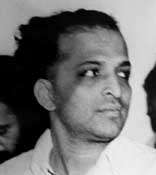Narayan Apte
| Narayan Apte | |
|---|---|
 | |
| Born | 1911 |
| Died |
15 November 1949 (aged 38) Ambala Prison, East Punjab, India (now in Haryana, India) |
| Cause of death | Execution by hanging |
| Nationality | Indian |
| Known for | Assassination of Mohandas Karamchand Gandhi |

Narayan Dattatraya Apte (1911 – 15 November 1949) was an Indian activist and entrepreneur who was executed for his role in the assassination of Mahatma Gandhi. He was a Brahmin from Poona who was born into a family of scholars.
Family
His father Dattatreya Apte was a Sanskrit scholar and a Historian. Narayan had 3 sisters and 4 brothers. Like most marriages, his marriage was arranged to Champa Fadtare, the daughter of an influential family from Poona. The marriage was said to have been a “perfect match” for each other. Champa later bore him a son.
Education and Work
Like the rest of his family, he developed a passion to learn and become a scholar. He graduated from Bombay University in 1932 with a Bachelor’s degree in Science. After three years of unemployment he was taken in as a tutor in Mission High School in Ahmednagar. He aspired to become a master in the field of education. Soon enough, he gave the “Bachelor of Education” degree exam and passed. He started a shooting club in Ahmednagar which eventually gained a lot of publicity and was duplicated in places like Pune.
In 1939, he joined the Ahmednagar branch of the Hindu Mahasabha under Vinod R. Karkare.[1] With the outbreak of the Second World War, the then president of the Hindu Mahasabha, Vinayak Damodar Savarkar ordered the party members to help the British in any way possible. Apte shot up the ranks to be a recruiter in the Poona region and a flight lieutenant. He was eventually offered a permanent job with the RAF. This would’ve been ideal for him as it would’ve meant subsidised goods, a good salary, a pension and various other perks. However, he didn’t end up taking it, giving the following reasons which included his father’s death and the transfer of the burden of being the head of a joint family and the fact that his son’s conditioned was worsening.
With the recruitement scene in Poona being very poor, Narayan had a lot of time on his hands. He eventually started working closely with Nathuram Godse in the Hindu Mahasabha. At this juncture, Savarkar launched the Hindu Rashtra Dal which was intended to be a radical wing of the Mahasabha. Its aims included disrupting Congress meetings and heckling Congress leaders.
In 1944, Godse broached the topic of starting a newspaper called “Agranee” encompassing the ideals of the Dal and the Mahasabha. The newspaper seemed to be failing miserably, however Savarkar managed to keep it alive by constantly sending generous donations. The content was highly rabid and infringed the Bombay Press Act. Just before the government issued orders to close it down, they renamed the paper to the Hindu Rashtra. Godse formed a bond of subordination to the extroverted and flamboyant Narayan Apte.
See also
Notes
- ↑ citation needed